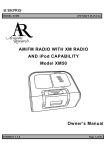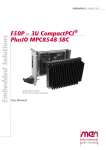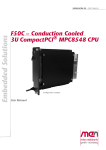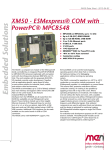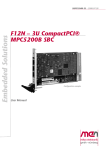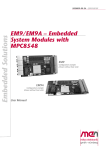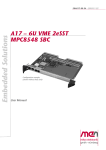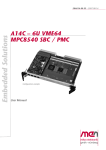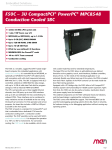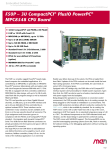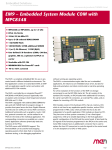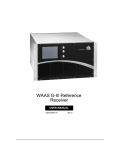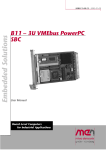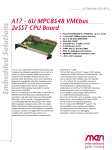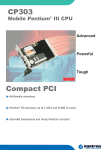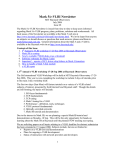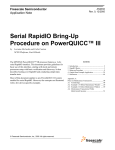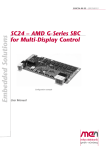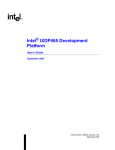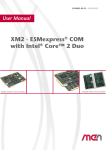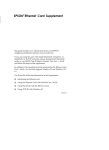Download 20XM50-00 E5 User Manual - Diamond Point International
Transcript
20XM50-00 E5 – 2014-02-25
User Manual
XM50 – ESMexpress® COM
with PowerPC® MPC8548
Module without cover and frame
XM50 – ESMexpress® COM with PowerPC® MPC8548
XM50 – ESMexpress® COM with PowerPC® MPC8548
The XM50 is a computer-on-module of the ESMexpress® family controlled by an
integrated PowerPC® MPC8548 or MPC8543 CPU processor (optionally with
encryption unit) with clock frequencies between 800 MHz and 1.5 GHz. Together
with an application-specific carrier board it forms a semi-custom solution for
industrial, harsh, mobile and mission-critical environments.
The XM50 accommodates up to 2 GB of directly soldered ECC main memory and
supports other memory like USB Flash on the carrier board. It also features
industrial FRAM and SRAM.
Interfaces from the MPC8548 are all routed from the XM50 for availability on any
ESMexpress® carrier board. Those interfaces include up to three Gigabit Ethernet
channels, 8 PCI Express® lanes for one link (x4, x2 or x1, or x8 as an option), triple
SATA, 6 USB host ports and one USB client realized using a UART-to-USB
converter. Additional COM interfaces can be made available on the carrier board via
USB to COM conversion.
The XM50 comes with MENMON support. This firmware/BIOS can be used for
bootstrapping operating systems (from disk, Flash or network), for hardware testing,
or for debugging applications without running any operating system.
The XM50 is screened for operation in a -50°C to +85°C conduction or convection
cooled environment. As all ESMexpress® modules it is embedded in a covered
frame. This ensures EMC protection and allows efficient conductive cooling. Air
cooling is also possible by applying a heat sink on top of the cover. Where operating
temperatures are moderate, the module may even do without the frame and cover,
with a suitable low-power processor and airflow. ESMexpress® modules are firmly
screwed to a carrier board and come with rugged industry-proven connectors
supporting high frequency and differential signals. Only soldered components are
used to withstand shock and vibration, and the design is optimized for conformal
coating. All ESMexpress® modules support a single 95x125mm form factor.
For evaluation and development purposes an ATX carrier board is available. The
ESMexpress® module can be evaluated on a COM Express® carrier board via an
adapter from ESMexpress® to COM Express®.
MEN Mikro Elektronik GmbH
20XM50-00 E5 – 2014-02-25
2
Diagram
Diagram
B Onboard connector
Options
Boot Flash
ECC DDR2 SDRAM
FRAM
SRAM
Gb Ethernet
EEPROM
Gb Ethernet (MPC8548)
I2C
RTC
Supervisor
PowerPC®
MPC8548
or MPC8543
UART
UART‐to‐USB
PCI Bus 33
PCI‐to‐USB (6 ports)
(MPC8543)
PCIe x4 (x8)
PCI Bus 66 PCI‐to‐SATA (3 ports)
(MPC8548)
ESMexpress® Connectors
MEN Mikro Elektronik GmbH
20XM50-00 E5 – 2014-02-25
B
3
Technical Data
Technical Data
CPU
• PowerPC® PowerQUICC™ III MPC8548, MPC8548E, MPC8543 or
MPC8543E
- 800 MHz up to 1.5 GHz
- Please see Standard Configurations for available standard versions.
- e500 PowerPC® core with MMU and double-precision embedded scalar and
vector floating-point APU
- Integrated Northbridge and Southbridge
Memory
• 2x 32 KB L1 data and instruction cache, 512 KB / 256 KB L2 cache integrated in
MPC8548/MPC8543
• Up to 2 GB SDRAM system memory
- Soldered
- DDR2 with or without ECC
- Up to 300 MHz memory bus frequency, depending on CPU
• 16 MB boot Flash
• 2 MB non-volatile SRAM
- With GoldCap or battery backup on the carrier board
• 128 KB non-volatile FRAM
• Serial EEPROM 8 kbits for factory settings
Serial ATA (SATA)
•
•
•
•
Three ports via ESMexpress® connector
SATA Revision 1.x support
Transfer rates up to 150 MB/s (1.5 Gbit/s)
Via PCI-to-SATA bridge
USB
• Six USB 2.0 host ports via ESMexpress® connector
- OHCI and EHCI implementation
- Data rates up to 480 Mbit/s
• One USB client port via ESMexpress® connector
- Via UART-to-USB converter
- Data rates up to 115.2 kbit/s
- 16-byte transmit/receive buffer
- Handshake lines: none
MEN Mikro Elektronik GmbH
20XM50-00 E5 – 2014-02-25
4
Technical Data
Ethernet
• Three 10/100/1000Base-T Ethernet channels with MPC8548/E
• Two 10/100/1000Base-T Ethernet channels with MPC8543/E
• Two LED signals per channel for LAN link and activity status and connection
speed
• Accessible via ESMexpress® connector
PCI Express®
• One x1 or one x2 or one x4 link via ESMexpress® connector
• PCIe® 1.x support
• Data rate 250 MB/s in each direction (2.5 Gbit/s per lane)
GPIO
• 1 line from board controller via ESMexpress® connector
• Usable for LED
Miscellaneous
• Real-time clock (with GoldCap or battery backup on the carrier board)
• Temperature sensor, power supervision and watchdog
Electrical Specifications
• Supply voltage/power consumption:
- +12V (9..16 V), 12 W approx.
Mechanical Specifications
• Dimensions: 95 mm x 125 mm (conforming to ESMexpress® specification)
• ESMexpress® PCB mounted between a frame and a cover
• Weight: 250 g (incl. cover and frame)
Environmental Specifications
• Temperature range (operation): -50..+85°C Tcase (ESMexpress® cover/frame)
(screened)
• Temperature range (storage): -50..+85°C
• Relative humidity (operation): max. 95% non-condensing
• Relative humidity (storage): max. 95% non-condensing
• Altitude: -300 m to +3,000 m
• Shock: 15 g, 11 ms (EN 60068-2-27)
• Bump: 10 g, 16 ms (EN 60068-2-29)
• Vibration (sinusoidal): 1 g, 10 Hz – 150 Hz (EN 60068-2-6)
• Conformal coating on request
MTBF
• 209,732h @ 40°C according to IEC/TR 62380 (RDF 2000)
MEN Mikro Elektronik GmbH
20XM50-00 E5 – 2014-02-25
5
Technical Data
Safety
• PCB manufactured with a flammability rating of 94V-0 by UL recognized
manufacturers
EMC
• EMC behavior depends on the system and housing surrounding the
ESMexpress® module.
• MEN has performed general, successful EMC tests for ESMexpress® using the
XC1 evaluation carrier according to:
- EN 55022 (radio disturbance)
- IEC 61000-4-2 (ESD)
- IEC 61000-4-3 (electromagnetic field immunity)
- IEC 61000-4-4 (burst)
- IEC 61000-4-5 (surge)
- IEC 61000-4-6 (conducted disturbances)
BIOS
• MENMON
Software Support
•
•
•
•
Linux
VxWorks®
QNX® (on request; support of the FPU is currently not provided by QNX®)
INTEGRITY® (Green Hills® Software) support available. Please contact Green
Hills® for further information.
• OS-9® (on request)
• For more information on supported operating system versions and drivers see
online data sheet.
MEN Mikro Elektronik GmbH
20XM50-00 E5 – 2014-02-25
6
Configuration Options
Configuration Options
CPU
• Several PowerQUICC™ III types with different clock frequencies
• MPC8548 or MPC8548E
- 1 GHz, 1.2 GHz, 1.33 GHz or 1.5 GHz
• MPC8543 or MPC8543E
- 800 MHz or 1 GHz
Memory
• System RAM
- 512 MB, 1 GB or 2 GB
- With or without ECC
• SRAM
- 0 MB or 2 MB
• FRAM
- 0 KB or 128 KB
I/O
• Ethernet
- Only two channels instead of three with MPC8543
• PCI Express® links: one x8 link
- Reduces operation temperature range because of higher DDR SDRAM clock
Software Support
• QNX® (on request; support of the FPU is currently not provided by QNX®)
• OS-9® (on request)
Please note that some of these options may only be available for large volumes.
Please ask our sales staff for more information.
For available standard configurations see online data sheet.
MEN Mikro Elektronik GmbH
20XM50-00 E5 – 2014-02-25
7
Product Safety
Product Safety
!
Electrostatic Discharge (ESD)
Computer boards and components contain electrostatic sensitive devices.
Electrostatic discharge (ESD) can damage components. To protect the board and
other components against damage from static electricity, you should follow some
precautions whenever you work on your computer.
• Power down and unplug your computer system when working on the inside.
• Hold components by the edges and try not to touch the IC chips, leads, or
circuitry.
• Use a grounded wrist strap before handling computer components.
• Place components on a grounded antistatic pad or on the bag that came with the
component whenever the components are separated from the system.
• Store the board only in its original ESD-protected packaging. Retain the original
packaging in case you need to return the board to MEN for repair.
MEN Mikro Elektronik GmbH
20XM50-00 E5 – 2014-02-25
8
About this Document
About this Document
This user manual is intended only for system developers and integrators, it is not
intended for end users.
It describes the hardware functions of the board, connection of peripheral devices
and integration into a system. It also provides additional information for special
applications and configurations of the board.
The manual does not include detailed information on individual components (data
sheets etc.). A list of literature is given in the appendix.
History
Issue
Date
E1
First edition
2008-07-10
E2
Corrected USB device number and IDs in PCI
device table; corrected SMB device table; added
MTBF value
2008-11-27
E3
General update, minor errors corrected
2011-07-28
E4
Clarified technical data and options, added Table 31.
PCIe IRQ line mapping, general improvements,
minor errors corrected
2012-02-01
E5
Removed all ANSI-VITA 59 references, minor errors
corrected
2014-02-25
MEN Mikro Elektronik GmbH
20XM50-00 E5 – 2014-02-25
Comments
9
About this Document
Conventions
This sign marks important notes or warnings concerning the use of voltages which
can lead to serious damage to your health and also cause damage or destruction of
the component.
!
italics
bold
monospace
This sign marks important notes or warnings concerning proper functionality of the
product described in this document. You should read them in any case.
Folder, file and function names are printed in italics.
Bold type is used for emphasis.
A monospaced font type is used for hexadecimal numbers, listings, C function
descriptions or wherever appropriate. Hexadecimal numbers are preceded by "0x".
comment
Comments embedded into coding examples are shown in green color.
hyperlink
Hyperlinks are printed in blue color.
The globe will show you where hyperlinks lead directly to the Internet, so you can
look for the latest information online.
IRQ#
/IRQ
Signal names followed by "#" or preceded by a slash ("/") indicate that this signal is
either active low or that it becomes active at a falling edge.
in/out
Signal directions in signal mnemonics tables generally refer to the corresponding
board or component, "in" meaning "to the board or component", "out" meaning
"coming from it".
Vertical lines on the outer margin signal technical changes to the previous issue of
the document.
MEN Mikro Elektronik GmbH
20XM50-00 E5 – 2014-02-25
10
About this Document
Legal Information
Changes
MEN Mikro Elektronik GmbH ("MEN") reserves the right to make changes without further notice to any products
herein.
Warranty, Guarantee, Liability
MEN makes no warranty, representation or guarantee of any kind regarding the suitability of its products for any
particular purpose, nor does MEN assume any liability arising out of the application or use of any product or
circuit, and specifically disclaims any and all liability, including, without limitation, consequential or incidental
damages. TO THE EXTENT APPLICABLE, SPECIFICALLY EXCLUDED ARE ANY IMPLIED
WARRANTIES ARISING BY OPERATION OF LAW, CUSTOM OR USAGE, INCLUDING WITHOUT
LIMITATION, THE IMPLIED WARRANTIES OF MERCHANTABILITY AND FITNESS FOR A
PARTICULAR PURPOSE OR USE. In no event shall MEN be liable for more than the contract price for the
products in question. If buyer does not notify MEN in writing within the foregoing warranty period, MEN shall
have no liability or obligation to buyer hereunder.
The publication is provided on the terms and understanding that:
1. MEN is not responsible for the results of any actions taken on the basis of information in the publication, nor
for any error in or omission from the publication; and
2. MEN is not engaged in rendering technical or other advice or services.
MEN expressly disclaims all and any liability and responsibility to any person, whether a reader of the publication
or not, in respect of anything, and of the consequences of anything, done or omitted to be done by any such person
in reliance, whether wholly or partially, on the whole or any part of the contents of the publication.
Conditions for Use, Field of Application
The correct function of MEN products in mission-critical and life-critical applications is limited to the
environmental specification given for each product in the technical user manual. The correct function of MEN
products under extended environmental conditions is limited to the individual requirement specification and
subsequent validation documents for each product for the applicable use case and has to be agreed upon in writing
by MEN and the customer. Should the customer purchase or use MEN products for any unintended or
unauthorized application, the customer shall indemnify and hold MEN and its officers, employees, subsidiaries,
affiliates, and distributors harmless against all claims, costs, damages, and expenses, and reasonable attorney fees
arising out of, directly or indirectly, any claim or personal injury or death associated with such unintended or
unauthorized use, even if such claim alleges that MEN was negligent regarding the design or manufacture of the
part. In no case is MEN liable for the correct function of the technical installation where MEN products are a part
of.
Trademarks
All products or services mentioned in this publication are identified by the trademarks, service marks, or product
names as designated by the companies which market those products. The trademarks and registered trademarks
are held by the companies producing them. Inquiries concerning such trademarks should be made directly to those
companies.
Conformity
MEN products are no ready-made products for end users. They are tested according to the standards given in the
Technical Data and thus enable you to achieve certification of the product according to the standards applicable in
your field of application.
MEN Mikro Elektronik GmbH
20XM50-00 E5 – 2014-02-25
11
About this Document
RoHS
Since July 1, 2006 all MEN standard products comply with RoHS legislation.
Since January 2005 the SMD and manual soldering processes at MEN have already been completely lead-free.
Between June 2004 and June 30, 2006 MEN’s selected component suppliers have changed delivery to RoHScompliant parts. During this period any change and status was traceable through the MEN ERP system and the
boards gradually became RoHS-compliant.
WEEE Application
The WEEE directive does not apply to fixed industrial plants and tools. The compliance is the responsibility of the
company which puts the product on the market, as defined in the directive; components and sub-assemblies are
not subject to product compliance.
In other words: Since MEN does not deliver ready-made products to end users, the WEEE directive is not
applicable for MEN. Users are nevertheless recommended to properly recycle all electronic boards which have
passed their life cycle.
Nevertheless, MEN is registered as a manufacturer in Germany. The registration number can be provided on
request.
Copyright © 2014 MEN Mikro Elektronik GmbH. All rights reserved.
Germany
MEN Mikro Elektronik GmbH
Neuwieder Straße 3-7
90411 Nuremberg
Phone +49-911-99 33 5-0
Fax +49-911-99 33 5-901
E-mail [email protected]
www.men.de
MEN Mikro Elektronik GmbH
20XM50-00 E5 – 2014-02-25
France
MEN Mikro Elektronik SAS
18, rue René Cassin
ZA de la Châtelaine
74240 Gaillard
Phone +33 (0) 450-955-312
Fax +33 (0) 450-955-211
E-mail [email protected]
www.men-france.fr
USA
MEN Micro Inc.
860 Penllyn Blue Bell Pike
Blue Bell, PA 19422
Phone (215) 542-9575
Fax (215) 542-9577
E-mail [email protected]
www.menmicro.com
12
Contents
Contents
1 Getting Started . . . . . . . . . . . . . . . . . . . . . . . . . . . . . . . . . . . . . . . . . . . . . . . .
1.1 Map of the Board. . . . . . . . . . . . . . . . . . . . . . . . . . . . . . . . . . . . . . . . .
1.2 First Operation. . . . . . . . . . . . . . . . . . . . . . . . . . . . . . . . . . . . . . . . . . .
1.3 Installing Operating System Software. . . . . . . . . . . . . . . . . . . . . . . . .
17
17
19
20
2 Functional Description . . . . . . . . . . . . . . . . . . . . . . . . . . . . . . . . . . . . . . . . . .
2.1 Power Supply. . . . . . . . . . . . . . . . . . . . . . . . . . . . . . . . . . . . . . . . . . . .
2.2 Board Supervision . . . . . . . . . . . . . . . . . . . . . . . . . . . . . . . . . . . . . . . .
2.3 Real-Time Clock . . . . . . . . . . . . . . . . . . . . . . . . . . . . . . . . . . . . . . . . .
2.4 Processor Core. . . . . . . . . . . . . . . . . . . . . . . . . . . . . . . . . . . . . . . . . . .
2.4.1
General . . . . . . . . . . . . . . . . . . . . . . . . . . . . . . . . . . . . . . . . .
2.4.2
Thermal Considerations . . . . . . . . . . . . . . . . . . . . . . . . . . . .
2.5 Bus Structure . . . . . . . . . . . . . . . . . . . . . . . . . . . . . . . . . . . . . . . . . . . .
2.5.1
Host-to-PCI Bridge . . . . . . . . . . . . . . . . . . . . . . . . . . . . . . . .
2.5.2
Local PCI Buses . . . . . . . . . . . . . . . . . . . . . . . . . . . . . . . . . .
2.6 Memory and Mass Storage . . . . . . . . . . . . . . . . . . . . . . . . . . . . . . . . .
2.6.1
DRAM System Memory . . . . . . . . . . . . . . . . . . . . . . . . . . . .
2.6.2
FRAM . . . . . . . . . . . . . . . . . . . . . . . . . . . . . . . . . . . . . . . . . .
2.6.3
SRAM . . . . . . . . . . . . . . . . . . . . . . . . . . . . . . . . . . . . . . . . . .
2.6.4
Boot Flash . . . . . . . . . . . . . . . . . . . . . . . . . . . . . . . . . . . . . . .
2.6.5
EEPROM. . . . . . . . . . . . . . . . . . . . . . . . . . . . . . . . . . . . . . . .
2.6.6
Serial ATA (SATA) . . . . . . . . . . . . . . . . . . . . . . . . . . . . . . . .
2.7 USB Interfaces. . . . . . . . . . . . . . . . . . . . . . . . . . . . . . . . . . . . . . . . . . .
2.8 Ethernet Interfaces. . . . . . . . . . . . . . . . . . . . . . . . . . . . . . . . . . . . . . . .
2.9 GPIO . . . . . . . . . . . . . . . . . . . . . . . . . . . . . . . . . . . . . . . . . . . . . . . . . .
2.10 PCI Express Interface . . . . . . . . . . . . . . . . . . . . . . . . . . . . . . . . . . . . .
2.11 ESMexpress . . . . . . . . . . . . . . . . . . . . . . . . . . . . . . . . . . . . . . . . . . . . .
2.11.1 Mechanical Concept . . . . . . . . . . . . . . . . . . . . . . . . . . . . . . .
2.11.2 Thermal Concept. . . . . . . . . . . . . . . . . . . . . . . . . . . . . . . . . .
2.11.3 ESMexpress Connectors . . . . . . . . . . . . . . . . . . . . . . . . . . . .
2.11.4 Using an ESMexpress Module on a COM Express Carrier
Board . . . . . . . . . . . . . . . . . . . . . . . . . . . . . . . . . . . . . . . . . . .
21
21
21
21
22
22
22
23
23
23
24
24
24
24
24
24
24
25
25
26
26
27
27
27
29
3 MENMON . . . . . . . . . . . . . . . . . . . . . . . . . . . . . . . . . . . . . . . . . . . . . . . . . . . .
3.1 General . . . . . . . . . . . . . . . . . . . . . . . . . . . . . . . . . . . . . . . . . . . . . . . .
3.1.1
State Diagram . . . . . . . . . . . . . . . . . . . . . . . . . . . . . . . . . . . .
3.2 Interacting with MENMON . . . . . . . . . . . . . . . . . . . . . . . . . . . . . . . .
3.2.1
Entering the Setup Menu/Command Line . . . . . . . . . . . . . .
3.3 Configuring MENMON for Automatic Boot . . . . . . . . . . . . . . . . . . .
3.4 Calibrating the Touch Screen . . . . . . . . . . . . . . . . . . . . . . . . . . . . . . .
3.5 Updating Boot Flash . . . . . . . . . . . . . . . . . . . . . . . . . . . . . . . . . . . . . .
39
39
40
42
42
43
43
44
MEN Mikro Elektronik GmbH
20XM50-00 E5 – 2014-02-25
36
13
Contents
3.5.1
Update via the Serial Console using SERDL . . . . . . . . . . . .
3.5.2
Update from Network using NDL. . . . . . . . . . . . . . . . . . . . .
3.5.3
Update via Program Update Menu . . . . . . . . . . . . . . . . . . . .
3.5.4
Automatic Update Check . . . . . . . . . . . . . . . . . . . . . . . . . . .
3.5.5
Updating MENMON Code . . . . . . . . . . . . . . . . . . . . . . . . . .
3.6 Diagnostic Tests. . . . . . . . . . . . . . . . . . . . . . . . . . . . . . . . . . . . . . . . . .
3.6.1
Ethernet . . . . . . . . . . . . . . . . . . . . . . . . . . . . . . . . . . . . . . . . .
3.6.2
SDRAM, SRAM and FRAM . . . . . . . . . . . . . . . . . . . . . . . .
3.6.3
EEPROM. . . . . . . . . . . . . . . . . . . . . . . . . . . . . . . . . . . . . . . .
3.6.4
USB . . . . . . . . . . . . . . . . . . . . . . . . . . . . . . . . . . . . . . . . . . . .
3.6.5
Hardware Monitor Test . . . . . . . . . . . . . . . . . . . . . . . . . . . . .
3.6.6
Touch. . . . . . . . . . . . . . . . . . . . . . . . . . . . . . . . . . . . . . . . . . .
3.6.7
RTC . . . . . . . . . . . . . . . . . . . . . . . . . . . . . . . . . . . . . . . . . . . .
3.7 MENMON Configuration and Organization . . . . . . . . . . . . . . . . . . . .
3.7.1
Consoles . . . . . . . . . . . . . . . . . . . . . . . . . . . . . . . . . . . . . . . .
3.7.2
Abort Pin . . . . . . . . . . . . . . . . . . . . . . . . . . . . . . . . . . . . . . . .
3.7.3
MENMON Memory Map . . . . . . . . . . . . . . . . . . . . . . . . . . .
3.7.4
MENMON BIOS Logical Units . . . . . . . . . . . . . . . . . . . . . .
3.7.5
System Parameters . . . . . . . . . . . . . . . . . . . . . . . . . . . . . . . .
3.8 MENMON Commands . . . . . . . . . . . . . . . . . . . . . . . . . . . . . . . . . . . .
44
44
44
44
45
46
46
47
48
49
49
49
50
51
51
52
53
54
55
60
4 Organization of the Board . . . . . . . . . . . . . . . . . . . . . . . . . . . . . . . . . . . . . . .
4.1 Memory Mappings . . . . . . . . . . . . . . . . . . . . . . . . . . . . . . . . . . . . . . .
4.2 Interrupt Handling . . . . . . . . . . . . . . . . . . . . . . . . . . . . . . . . . . . . . . . .
4.3 SMB Devices . . . . . . . . . . . . . . . . . . . . . . . . . . . . . . . . . . . . . . . . . . . .
4.4 Onboard PCI Devices . . . . . . . . . . . . . . . . . . . . . . . . . . . . . . . . . . . . .
62
62
63
63
64
5 Appendix . . . . . . . . . . . . . . . . . . . . . . . . . . . . . . . . . . . . . . . . . . . . . . . . . . . . .
5.1 Literature and Web Resources . . . . . . . . . . . . . . . . . . . . . . . . . . . . . . .
5.1.1
PowerPC . . . . . . . . . . . . . . . . . . . . . . . . . . . . . . . . . . . . . . . .
5.1.2
SATA . . . . . . . . . . . . . . . . . . . . . . . . . . . . . . . . . . . . . . . . . . .
5.1.3
USB . . . . . . . . . . . . . . . . . . . . . . . . . . . . . . . . . . . . . . . . . . . .
5.1.4
Ethernet . . . . . . . . . . . . . . . . . . . . . . . . . . . . . . . . . . . . . . . . .
5.1.5
PCI Express. . . . . . . . . . . . . . . . . . . . . . . . . . . . . . . . . . . . . .
5.2 Finding out the Board’s Article Number, Revision and
Serial Number . . . . . . . . . . . . . . . . . . . . . . . . . . . . . . . . . . . . . . . . . . .
65
65
65
65
65
65
65
MEN Mikro Elektronik GmbH
20XM50-00 E5 – 2014-02-25
66
14
Figures
Figure 1. Map of the board – cover side . . . . . . . . . . . . . . . . . . . . . . . . . . . . . . .
Figure 2. Map of the board – connector side . . . . . . . . . . . . . . . . . . . . . . . . . . . .
Figure 3. ESMexpress thermal concept: cooling wings between frame and
cover . . . . . . . . . . . . . . . . . . . . . . . . . . . . . . . . . . . . . . . . . . . . . . . . . . .
Figure 4. AE12 COM Express adapter board – Map of the board. . . . . . . . . . . .
Figure 5. MENMON – State diagram, Degraded Mode/Full Mode . . . . . . . . . .
Figure 6. MENMON – State diagram, main state . . . . . . . . . . . . . . . . . . . . . . . .
Figure 7. MENMON – Position of abort pins on test connector (bottom side). .
Figure 8. Labels giving the board’s article number, revision and serial
number . . . . . . . . . . . . . . . . . . . . . . . . . . . . . . . . . . . . . . . . . . . . . . . . .
MEN Mikro Elektronik GmbH
20XM50-00 E5 – 2014-02-25
17
18
28
36
40
41
52
66
15
Tables
Table 1.
Table 2.
Table 3.
Table 4.
Table 5.
Table 6.
Table 7.
Table 8.
Table 9.
Table 10.
Table 11.
Table 12.
Table 13.
Table 14.
Table 15.
Table 16.
Table 17.
Table 18.
Table 19.
Table 20.
Table 21.
Table 22.
Table 23.
Table 24.
Table 25.
Table 26.
Table 27.
Table 28.
Table 29.
Table 30.
Table 31.
Table 32.
Table 33.
MEN Mikro Elektronik GmbH
20XM50-00 E5 – 2014-02-25
Processor core options on XM50 . . . . . . . . . . . . . . . . . . . . . . . . . . . . .
Possible PCI Express link configurations. . . . . . . . . . . . . . . . . . . . . . .
Pin assignment of ESMexpress connector J1, pins 61..120 . . . . . . . . .
Pin assignment of ESMexpress connector J1, pins 1..60 . . . . . . . . . . .
Pin assignment of ESMexpress connector J2, pins 61..120 . . . . . . . . .
Pin assignment of ESMexpress connector J2, pins 1..60 . . . . . . . . . . .
Signal mnemonics of 120-pin ESMexpress connectors . . . . . . . . . . . .
MENMON – Program update files and locations . . . . . . . . . . . . . . . .
MENMON – Diagnostic tests: Ethernet. . . . . . . . . . . . . . . . . . . . . . . .
MENMON – Diagnostic tests: SDRAM, SRAM and FRAM . . . . . . .
MENMON – Diagnostic tests: EEPROM . . . . . . . . . . . . . . . . . . . . . .
MENMON – Diagnostic tests: USB. . . . . . . . . . . . . . . . . . . . . . . . . . .
MENMON – Diagnostic tests: hardware monitor . . . . . . . . . . . . . . . .
MENMON – Diagnostic tests: touch . . . . . . . . . . . . . . . . . . . . . . . . . .
MENMON – Diagnostic tests: RTC. . . . . . . . . . . . . . . . . . . . . . . . . . .
MENMON – System parameters for console selection and
configuration. . . . . . . . . . . . . . . . . . . . . . . . . . . . . . . . . . . . . . . . . . . . .
MENMON – Address map (full-featured mode) . . . . . . . . . . . . . . . . .
MENMON – Boot Flash memory map . . . . . . . . . . . . . . . . . . . . . . . .
MENMON – Controller Logical Units (CLUNs). . . . . . . . . . . . . . . . .
MENMON – Device Logical Units (DLUNs) . . . . . . . . . . . . . . . . . . .
MENMON – XM50 system parameters – Autodetected parameters . .
MENMON – XM50 system parameters – Production data . . . . . . . . .
MENMON – XM50 system parameters – MENMON persistent
parameters. . . . . . . . . . . . . . . . . . . . . . . . . . . . . . . . . . . . . . . . . . . . . . .
MENMON – XM50 system parameters – VxWorks bootline
parameters. . . . . . . . . . . . . . . . . . . . . . . . . . . . . . . . . . . . . . . . . . . . . . .
MENMON – Reset causes through system parameter rststat. . . . . . . .
MENMON – Command reference . . . . . . . . . . . . . . . . . . . . . . . . . . . .
Memory map – processor view . . . . . . . . . . . . . . . . . . . . . . . . . . . . . .
Address mapping for PCI . . . . . . . . . . . . . . . . . . . . . . . . . . . . . . . . . . .
Dedicated interrupt line assignment . . . . . . . . . . . . . . . . . . . . . . . . . . .
PCI IRQ line mapping . . . . . . . . . . . . . . . . . . . . . . . . . . . . . . . . . . . . .
PCIe IRQ line mapping . . . . . . . . . . . . . . . . . . . . . . . . . . . . . . . . . . . .
SMB devices. . . . . . . . . . . . . . . . . . . . . . . . . . . . . . . . . . . . . . . . . . . . .
Onboard PCI devices . . . . . . . . . . . . . . . . . . . . . . . . . . . . . . . . . . . . . .
22
26
30
31
32
33
34
44
46
47
48
49
49
49
50
51
53
53
54
54
55
56
57
59
59
60
62
62
63
63
63
63
64
16
Getting Started
1
Getting Started
This chapter gives an overview of the board and some hints for first installation in a
system.
1.1
Map of the Board
The following board map shows the board assembly from its cover side (top) and
connector side (bottom). The cover includes holes for mounting the ESMexpress
module onto a COM Express carrier.
Figure 1. Map of the board – cover side
J2
Top cover
ESMexpress connectors
(on bottom side)
1
J1
1
Screw holes to install ESMexpress module on a COM Express carrier
MEN Mikro Elektronik GmbH
20XM50-00 E5 – 2014-02-25
17
Getting Started
Figure 2. Map of the board – connector side
Cooling wing
Cooling wing
119
J2
61
59
119
J1
ESMexpress
connectors
Cooling wing
Cooling wing
1
Frame
61
59
1
Cooling wing
Cooling wing
Holes for mounting screws on carrier board
Screws connecting the frame and cover. Don’t remove!
MEN Mikro Elektronik GmbH
20XM50-00 E5 – 2014-02-25
18
Getting Started
1.2
First Operation
You can use the following check list when installing the board for the first time and
with minimum configuration using a Windows host PC.
Power-down the system.
Install the XM50 on your ESMexpress carrier board, making sure that the
ESMexpress connectors are properly aligned.
To provide a better example, we assume that you are using MEN’s standard
evaluation carrier, XC1, which provides the necessary connections, for a Windows
host PC. You can find more information on the XC1 in the XC1 User Manual, which
is available for download on MEN’s website.
Install a USB-to-UART driver on your host PC.
You can use a driver provided by MEN (article number 13T005-70, third-party)
or go to the FTDI web site (www.ftdichip.com/FTDrivers.htm) and download a
driver there.
Connect a Windows PC to USB port 7 of XC1 (UART-to-USB COM interface).
To do this, you need a suitable USB cable (type A to A, included with XC1).
ETHA
ETHB
ETHC
USB0
USB2
USB6
USB1
USB3
USB7
Audio out
DVI
Power-up the system.
Start up a terminal program on your Windows PC, e.g., HyperTerm, and open a
terminal connection.
Set your terminal connection to the following protocol:
-
9600 baud data transmission rate
8 data bits
1 stop bit
No parity
When the terminal connection is made, press Enter. Now you can use the
MENMON BIOS/firmware (see detailed description in Chapter 3 MENMON
on page 39).
MEN Mikro Elektronik GmbH
20XM50-00 E5 – 2014-02-25
19
Getting Started
If you enter command "LOGO" on the MENMON prompt, the terminal
displays a message similar to the following:
________ Secondary MENMON for MEN MPC8548 Family (XM50) Beta1.5work2 ________
|
|
|
(c) 2007 - 2008 MEN Mikro Elektronik GmbH Nuremberg
|
|
MENMON 2nd Edition, Created Jun 12 2008
10:45:08
|
|_____________________________________________________________________________|
|
CPU Board: XM50-00
|
CPU: MPC8548
|
|Serial Number: 4
|
CPU/MEM Clk:
1386 / 198 MHz
|
| HW Revision: 00.00.00
|
CCB/LBC Clk:
396 / 50 MHz
|
|
|
|
|
PCI1/PCI2: 32Bit 66MHz/32Bit 33MHz|
PCIe:
x4
|
|
DDR2 SDRAM: 512 MB ECC on 3.0/3/8 |
FRAM/SRAM:
128 /2048 kB
|
|
Produced:
|
FLASH:
16 MB
|
| Last repair:
|
Reset Cause: Power On
|
|_____________________________________________________________________________|
| Carrier Board: XC01-00, Rev 00.01.00, Serial 3
|
\___________________________________________________________________________/
Note: Don’t power off the XM50 now, otherwise the USB-to-UART interface on the
host PC will be disconnected.
Observe the installation instructions for the respective software.
1.3
Installing Operating System Software
The board supports Linux, VxWorks, INTEGRITY, QNX and OS-9.
!
By standard, no operating system is installed on the board. Please refer to the
operating system installation documentation on how to install the software!
You can find any software available on MEN’s website.
MEN Mikro Elektronik GmbH
20XM50-00 E5 – 2014-02-25
20
Functional Description
2
Functional Description
The following describes the individual functions of the board and their
configuration on the board. There is no detailed description of the individual
controller chips and the CPU. They can be obtained from the data sheets or data
books of the semiconductor manufacturer concerned (Chapter 5.1 Literature and
Web Resources on page 65).
2.1
Power Supply
The XM50 board is supplied with +12V (9 to 16V) only via ESMexpress connectors
J1/J2.
All other required voltages are generated on the board.
2.2
Board Supervision
The board features a temperature sensor and voltage monitor.
A voltage monitor supervises all used voltages and holds the CPU in reset condition
until all supply voltages are within their nominal values.
In addition the board contains a PLD watchdog that must be triggered. After
configuration the CPU serves the PLD watchdog. The watchdog timeout is
automatically set to 1.12 s after the first trigger pulse by the CPU.
The watchdog can be enabled or disabled through MENMON and can be triggered
by a software application. This function is normally supported by the board support
package (see BSP documentation).
2.3
Real-Time Clock
The board includes an RA8581 real-time clock. Interrupt generation of the RTC is
not supported. For data retention during power off the RTC must be supplied with
3V via J1 pin Vbatt (J1-55) using an external GoldCap or battery device mounted on
the carrier board.
A control flag indicates a back-up power fail condition. In this case the contents of
the RTC cannot be expected to be valid. A message will be displayed on the
MENMON console in this case.
MEN Mikro Elektronik GmbH
20XM50-00 E5 – 2014-02-25
21
Functional Description
2.4
Processor Core
The board is equipped with the MPC8548 or MPC8543 processor, which includes a
32-bit PowerPC e500 core, the integrated host-to-PCI bridge, Ethernet controllers
and UARTs.
2.4.1
General
The MPC8548/3 family of processors integrates an e500v2 processor core built on
Power Architecture technology with system logic required for networking,
telecommunications, and wireless infrastructure applications. The MPC8548/3 is a
member of the PowerQUICC III family of devices that combine system-level
support for industry-standard interfaces with processors that implement the
embedded category of the Power Architecture technology.
The MPC8548/3 offers a double-precision floating-point auxiliary processing unit
(APU), up to 512 KB of level-2 cache, up to four integrated 10/100/1Gbits/s
enhanced three-speed Ethernet controllers with TCP/IP acceleration and
classification capabilities, a DDR/DDR2 SDRAM memory controller, a
programmable interrupt controller, two I²C controllers, a four-channel DMA
controller, a general-purpose I/O port, and dual universal asynchronous receiver/
transmitters (DUART).
The MPC8548/3 is available with (MPC8548/3E) or without an integrated security
engine with XOR acceleration.
Table 1. Processor core options on XM50
Processor Type
Core Frequency
L2 Cache
Encryption Unit
Ethernet Ports
MPC8548
1 GHz, 1.2 GHz, 1.33 GHz or
1.5 GHz
512 KB
No
3
MPC8548E
1 GHz, 1.2 GHz, 1.33 GHz or
1.5 GHz
512 KB
Yes
3
MPC8543
800 MHz or 1 GHz
256 KB
No
2
MPC8543E
800 MHz or 1 GHz
256 KB
Yes
2
2.4.2
Thermal Considerations
The XM50 generates around 12 W of power dissipation when operated at 1.33 GHz.
The ESMexpress module is enclosed inside a cover and frame and therefore
provides a flexible thermal interface that can be used as needed to fulfill the thermal
needs of the application. Typically you should use it for conduction cooling or
convection cooling. It depends on the system configuration and airflow if an
additional heat sink is needed or not. In any case you should check your thermal
conditions and implement appropriate cooling.
See also Chapter 2.11.2 Thermal Concept on page 27.
!
Please note that if you do not use the cover and frame supplied by MEN and/or no
heat sink, warranty on functionality and reliability of the XM50 may cease. If you
have any questions or problems regarding thermal behavior, please contact MEN.
MEN Mikro Elektronik GmbH
20XM50-00 E5 – 2014-02-25
22
Functional Description
2.5
Bus Structure
2.5.1
Host-to-PCI Bridge
The integrated host-to-PCI bridge is used as host bridge and memory controller for
the PowerPC processor. All transactions of the PowerPC to the PCI bus are
controlled by the host bridge. The FRAM, SRAM and boot Flash are connected to
the local memory bus of the integrated host-to-PCI bridge.
The PCI interface is PCI bus Rev. 2.2 compliant and supports all bus commands and
transactions. Master and target operations are possible. Only big-endian operation is
supported.
2.5.2
Local PCI Buses
Two local PCI buses are controlled by the integrated host-to-PCI bridge. One is
connected to the PCI-to-USB bridge and runs at 33 MHz. The other connects the
PCI-to-SATA bridge and operates at 66 MHz. Board versions with the MPC8543
processor only have one local PCI bus operating at 33 MHz.
The I/O voltage is fixed to 3.3V. The data width is 32 bits.
MEN Mikro Elektronik GmbH
20XM50-00 E5 – 2014-02-25
23
Functional Description
2.6
Memory and Mass Storage
2.6.1
DRAM System Memory
The board provides up to 2 GB onboard, soldered DDR2 (double data rate) SDRAM
on nine memory components (incl. ECC). The memory bus is 72 bits wide and
operates at up to 300 MHz (physical), depending on the processor type.
Depending on the board version the SDRAM may have ECC (error-correcting
code). ECC memory provides greater data accuracy and system uptime by
protecting against soft errors in computer memory.
2.6.2
FRAM
The board has up to 128 KB non-volatile FRAM memory connected to the local bus
of the CPU.
The FRAM does not need a back-up voltage for data retention.
2.6.3
SRAM
The board has up to 2 MB non-volatile SRAM memory connected to the local bus
of the CPU.
For data retention during power off the SRAM must be supplied with a back-up
voltage of 3.3 V via J1 pin Vbatt (J1-55) using an external GoldCap or battery
device mounted on the carrier board.
2.6.4
Boot Flash
The board has 16 MB of onboard Flash. It is controlled by the CPU.
Flash memory contains the boot software for the MENMON/operating system
bootstrapper and application software. The MENMON sectors are softwareprotected against illegal write transactions through a password in the serial
download function of MENMON (cf. Chapter 3.5.1 Update via the Serial Console
using SERDL on page 44).
2.6.5
EEPROM
The board has an 8-kbit serial EEPROM for factory data.
2.6.6
Serial ATA (SATA)
The XM50 provides three serial ATA channels through a PCI-to-SATA converter
that is connected to the PowerPC processor via a dedicated 66-MHz PCI bus. (On
board versions with the MPC8543 processor PCI-to-SATA shares one 33-MHz PCI
bus with PCI-to-USB.) The SATA channels are led to the ESMexpress connector.
The SATA interfaces supports transfer rates up to 1.5 Gbits/s.
You can find the pinout for the SATA signals in Table 3, Pin assignment of
ESMexpress connector J1, pins 61..120 on page 30.
MEN Mikro Elektronik GmbH
20XM50-00 E5 – 2014-02-25
24
Functional Description
2.7
USB Interfaces
The XM50 provides six USB 2.0 host ports with OHCI/EHCI implementation and
one USB client port at the ESMexpress connector.
The six host ports are controlled via PCI-to-USB bridges from the PowerPC
processor, while the client port is driven by a UART-to-USB converter.
The UART-to-USB interface supports data rates up to 115.2 kbits/s. It has no
handshake lines. In connection with USB-to-UART driver software it can be used as
a COM interface and is supported by MENMON as a console device.
You can find the pinout for the USB signals in Table 3, Pin assignment of
ESMexpress connector J1, pins 61..120 on page 30 and Table 4, Pin assignment of
ESMexpress connector J1, pins 1..60 on page 31.
2.8
Ethernet Interfaces
The XM50 has up to three Ethernet interfaces controlled by the CPU. All channels
support up to 1000 Mbits/s and full-duplex operation.
!
Please note that ETHC is not available on board versions with the MPC8543
processor.
You can find the pinout for the Ethernet signals in Table 4, Pin assignment of
ESMexpress connector J1, pins 1..60 on page 31.
!
The unique MAC address is set at the factory and should not be changed. Any
attempt to change this address may create node or bus contention and thereby render
the board inoperable. The MAC addresses on XM50 are:
• ETHA:
• ETHB:
• ETHC:
0x 00 C0 3A 87 xx xx
0x 00 C0 3A 88 xx xx
0x 00 C0 3A 89 xx xx
where "00 C0 3A" is the MEN vendor code, "87", "88" and "89" are the MEN
product codes, and "xx xx" is the hexadecimal serial number of the product, which
depends on your board, e. g. "... 00 2A" for serial number "000042". (See Chapter
5.2 Finding out the Board’s Article Number, Revision and Serial Number on page
66.)
MEN Mikro Elektronik GmbH
20XM50-00 E5 – 2014-02-25
25
Functional Description
2.9
GPIO
The XM50 provides one GPIO pin driven by the board controller for user-defined
options or for a board status LED. This LED can be made available on the carrier
board.
You can find the GPIO pin in Table 4, Pin assignment of ESMexpress connector J1,
pins 1..60 on page 31.
2.10
PCI Express Interface
The PowerPC processor supports four PCI Express lanes which can be used as one
x1 or one x2 or one x4 link. Any link supports a data rate of 250 MB/s in each
direction with a bandwidth of 2.5 Gbits/s per lane. One x8 link is also possible on
request, but this reduces the XM50’s extended operation temperature range.
The following table shows which lanes must be used for each link type.
Table 2. Possible PCI Express link configurations
PCIe Lane
PCIe Link Configuration
PCIE_B7
x8
PCIE_B6
PCIE_B5
PCIE_B4
PCIE_B3
x4
PCIE_B2
PCIE_B1
PCIE_B0
x2
x1
Note: PCIE_B0..3 are standard, PCIE_B4..7 are an additional option.
The interface can be accessed on the ESMexpress connector.
You can find the pinout for the PCI Express signals in Table 3, Pin assignment of
ESMexpress connector J1, pins 61..120 on page 30, Table 5, Pin assignment of
ESMexpress connector J2, pins 61..120 on page 32 and Table 6, Pin assignment of
ESMexpress connector J2, pins 1..60 on page 33.
MEN Mikro Elektronik GmbH
20XM50-00 E5 – 2014-02-25
26
Functional Description
2.11
ESMexpress
ESMexpress is a Computer-On-Module (COM/SOM) standard that is especially
ruggedized and provides a high-performance, low-power architecture for harsh
environments.
The ESMexpress concept has been developed for applications that require highly
robust electronics to ensure safe and reliable operation even in severe environments,
e.g., in railways and avionics, industrial automation and medical engineering or
mobile applications in general.
Together with an application-specific carrier board, it forms a semi-custom solution
for industrial, harsh, mobile and mission-critical environments.
2.11.1
Mechanical Concept
ESMexpress modules are embedded in a frame and a cover, and are firmly screwed
to a carrier board. The frame and the cover ensure 100% EMC protection. Only
soldered components are used to withstand shock and vibration, and the design is
optimized for conformal coating. All ESMexpress modules support a single
95 x 125 mm form factor.
2.11.2
Thermal Concept
ESMexpress modules are equipped with eight cooling wings for conductive cooling.
The heat generated on the board is transported to the frame and the cover via the
cooling wings. The frame and the cover, however, are only part of the thermal
solution for a module. They only provide a common interface between the
ESMexpress module and implementation-specific thermal solutions.
The module can e.g. be cooled via conductive cooling, where the heat is transported
to a housing or a heat sink built on top of the cover. Where operating temperatures
are moderate, the module may even do without the frame and cover, with a suitable
low-power processor and airflow.
MEN Mikro Elektronik GmbH
20XM50-00 E5 – 2014-02-25
27
Functional Description
Figure 3. ESMexpress thermal concept: cooling wings between frame and cover
Cooling wing
Cooling wing
119
J2
61
59
119
J1
ESMexpress
connectors
Cooling wing
Cooling wing
1
Frame
61
59
1
Cooling wing
Cooling wing
Holes for mounting screws on carrier board
Screws connecting the frame and cover. Don’t remove!
Please contact MEN’s sales team for further information.
MEN Mikro Elektronik GmbH
20XM50-00 E5 – 2014-02-25
28
Functional Description
2.11.3
ESMexpress Connectors
The XM50 is connected to the carrier board via two 120-pin connectors.
Connector types:
• 2-row, 120-pin high-speed receptacle, 0.5mm pitch, e.g. Samtec QSH-060-01-L-D-A-K
• Mating connector:
2-row, 120-pin high-speed plug connector, 0.5mm pitch
!
Note: In the following pinout tables the ESMexpress
connectors are shown as if seen through the cover
side and PCB, i.e. the pin layout (position of pin 1)
will be the same on a carrier board.
J2
Cf. Figure 1, Map of the board – cover side (page 17)
and Figure 2, Map of the board – connector side
(page 18).
ESMexpress connectors
(on bottom side)
1
J1
1
MEN Mikro Elektronik GmbH
20XM50-00 E5 – 2014-02-25
29
Functional Description
Table 3. Pin assignment of ESMexpress connector J1, pins 61..120
119
120
61
62
59
60
119
PCIE_A0_TX+
120
PCIE_A0_RX+
117
PCIE_A0_TX-
118
PCIE_A0_RX-
115
GND
116
GND
113
PCIE_CLK_A0_REF+
114
-
111
PCIE_CLK_A0_REF-
112
-
109
GND
110
GND
107
-
108
-
105
-
106
-
103
-
104
-
101
-
102
-
99
-
100
-
97
GND
98
GND
95
SATA0_TX+
96
SATA0_RX+
93
SATA0_TX-
94
SATA0_RX-
91
GND
92
GND
89
SATA1_TX+
90
SATA1_RX+
87
SATA1_TX-
88
SATA1_RX-
85
GND
86
GND
83
SATA2_TX+
84
SATA2_RX+
81
SATA2_TX-
82
SATA2_RX-
79
GND
80
GND
77
USB0+
78
USB1+
75
USB0-
76
USB1-
73
USB_OC_0_1#
74
USB_OC_2_3#
71
USB2+
72
USB3+
69
USB2-
70
USB3-
67
GND
68
GND
65
USB4+
66
USB5+
63
USB4-
64
USB5-
61
USB_OC_4_5#
62
-
GND
The PCI Express pins shown in grey color are available on request for a x1 link, e.g.,
for special XM50 versions without a J2 connector.
MEN Mikro Elektronik GmbH
20XM50-00 E5 – 2014-02-25
30
Functional Description
Table 4. Pin assignment of ESMexpress connector J1, pins 1..60
61
62
59
60
1
MEN Mikro Elektronik GmbH
20XM50-00 E5 – 2014-02-25
2
59
-
60
UART-to-USB+
57
-
58
UART-to-USB-
55
Vbatt
56
-
53
PWR_OK
54
PS_ON#
51
SMB_DATA
52
RESET_IN#
49
SMB_CLK
50
RESET_OUT#
47
-
48
-
45
GPOUT/LED#
46
-
43
-
44
-
41
-
42
-
39
-
40
-
37
-
38
-
35
ETH_C_LED_LINK#
36
ETH_C_LED_ACT#
33
ETH_C0+
34
ETH_C1+
31
ETH_C0-
32
ETH_C1-
29
ETH_C2+
30
ETH_C3+
27
ETH_C2-
28
ETH_C3-
25
ETH_C_REF
26
GND
23
ETH_B_LED_LINK#
24
ETH_B_LED_ACT#
21
ETH_B0+
22
ETH_B1+
19
ETH_B0-
20
ETH_B1-
17
ETH_B2+
18
ETH_B3+
15
ETH_B2-
16
ETH_B3-
13
ETH_B_REF
14
GND
11
ETH_A_LED_LINK#
12
ETH_A_LED_ACT#
9
ETH_A0+
10
ETH_A1+
7
ETH_A0-
8
ETH_A1-
5
ETH_A2+
6
ETH_A3+
3
ETH_A2-
4
ETH_A3-
1
ETH_A_REF
2
GND
+12V
31
Functional Description
Table 5. Pin assignment of ESMexpress connector J2, pins 61..120
119
120
61
62
59
60
119
PCIE_B0_TX+
120
PCIE_B0_RX+
117
PCIE_B0_TX-
118
PCIE_B0_RX-
115
GND
116
GND
113
PCIE_B1_TX+
114
PCIE_B1_RX+
111
PCIE_B1_TX-
112
PCIE_B1_RX-
109
GND
110
GND
107
PCIE_B2_TX+
108
PCIE_B2_RX+
105
PCIE_B2_TX-
106
PCIE_B2_RX-
103
GND
104
GND
101
PCIE_B3_TX+
102
PCIE_B3_RX+
99
PCIE_B3_TX-
100
PCIE_B3_RX-
97
GND
98
GND
95
PCIE_B4_TX+
96
PCIE_B4_RX+
93
PCIE_B4_TX-
94
PCIE_B4_RX-
91
GND
92
GND
89
PCIE_B5_TX+
90
PCIE_B5_RX+
87
PCIE_B5_TX-
88
PCIE_B5_RX-
85
GND
86
GND
83
PCIE_B6_TX+
84
PCIE_B6_RX+
81
PCIE_B6_TX-
82
PCIE_B6_RX-
79
GND
80
GND
77
PCIE_B7_TX+
78
PCIE_B7_RX+
75
PCIE_B7_TX-
76
PCIE_B7_RX-
73
GND
74
GND
71
-
72
-
69
-
70
-
67
GND
68
GND
65
-
66
-
63
-
64
-
61
-
62
-
GND
The PCI Express pins shown in grey color are available as an option for a x8 link.
MEN Mikro Elektronik GmbH
20XM50-00 E5 – 2014-02-25
32
Functional Description
Table 6. Pin assignment of ESMexpress connector J2, pins 1..60
61
62
59
60
1
MEN Mikro Elektronik GmbH
20XM50-00 E5 – 2014-02-25
2
59
-
60
-
57
-
58
-
55
-
56
-
53
GND
54
GND
51
-
52
-
49
-
50
-
47
GND
48
GND
45
-
46
-
43
-
44
-
41
GND
42
GND
39
-
40
-
37
-
38
-
35
GND
36
GND
33
-
34
-
31
-
32
-
29
GND
30
GND
27
-
28
-
25
-
26
-
23
GND
24
GND
21
-
22
PCIE_CLK_B_REF+
19
-
20
PCIE_CLK_B_REF-
17
GND
18
GND
15
-
16
-
13
-
14
-
11
GND
12
GND
9
-
10
-
7
-
8
-
5
GND
6
GND
3
-
4
-
1
-
2
-
GND
33
Functional Description
Table 7. Signal mnemonics of 120-pin ESMexpress connectors
Signal
Power
GND
Direction
-
Vbatt
Power
PS_ON#
Management PWR_OK
PCI Express
SATA
USB
Function
Ground
3V battery voltage
out
Enable signal for external power supply
in
Power OK signal from external power supply
RESET_IN#
in
Reset signal from carrier board
RESET_OUT#
out
Reset signal from CPU board
PCIE_CLK_A0_REF+,
PCIE_CLK_A0_REF-
out
Reference clock A0 100 MHz (option for x1
link on J1)
PCIE_CLK_B_REF+,
PCIE_CLK_B_REF-
out
Reference clock B 100 MHz
PCIE_B[3:0]_RX+,
PCIE_B[3:0]_RX-
in
Differential PCIe receive lines, lanes 0 to 3
PCIE_B[3:0]_TX+,
PCIE_B[3:0]_TX-
out
Differential PCIe transmit lines, lanes 0 to 3
PCIE_B[7:4]_RX+,
PCIE_B[7:4]_RX-
in
Differential PCIe receive lines, lanes 4 to 7
(option for x8 link)
PCIE_B[7:4]_TX+,
PCIE_B[7:4]_TX-
out
Differential PCIe transmit lines, lanes 4 to 7
(option for x8 link)
SATA0_RX+, SATA0_RX-
in
Differential SATA receive lines, port 0
SATA0_TX+, SATA0_TX-
out
Differential SATA transmit lines, port 0
SATA1_RX+, SATA1_RX-
in
Differential SATA receive lines, port 1
SATA1_TX+, SATA1_TX-
out
Differential SATA transmit lines, port 1
SATA2_RX+, SATA2_RX-
in
Differential SATA receive lines, port 2
SATA2_TX+, SATA2_TX-
out
Differential SATA transmit lines, port 2
USB0+, USB0-
in/out
Differential USB lines, port 0
USB1+, USB1-
in/out
Differential USB lines, port 1
USB2+, USB2-
in/out
Differential USB lines, port 2
USB3+, USB3-
in/out
Differential USB lines, port 3
USB4+, USB4-
in/out
Differential USB lines, port 4
USB5+, USB5-
in/out
Differential USB lines, port 5
UART-to-USB+,
UART-to-USB-
in/out
Differential UART-to-USB lines (USB port 7)
USB_OC_0_1#
in
USB overcurrent, ports 0 and 1
USB_OC_2_3#
in
USB overcurrent, ports 2 and 3
USB_OC_4_5#
in
USB overcurrent, ports 4 and 5
USB_OC_6_7#
in
USB overcurrent, ports 6 and 7
MEN Mikro Elektronik GmbH
20XM50-00 E5 – 2014-02-25
34
Functional Description
Signal
Ethernet
Other
Direction
Function
ETH_A_LED_ACT#
out
Signal for activity status LED, port A
ETH_A_LED_LINK#
out
Signal for link status LED, port A
ETH_A0+, ETH_A0-
in/out
Media Dependent Interface [0] data,
differential pair, port A
ETH_A1+, ETH_A1-
in/out
Media Dependent Interface [1] data,
differential pair, port A
ETH_A2+, ETH_A2-
in/out
Media Dependent Interface [2] data,
differential pair, port A
ETH_A3+, ETH_A3-
in/out
Media Dependent Interface [3] data,
differential pair, port A
ETH_A_REF
out
Port A reference voltage
ETH_B_LED_ACT#
out
Signal for activity status LED, port B
ETH_B_LED_LINK#
out
Signal for link status LED, port B
ETH_B0+, ETH_B0-
in/out
Media Dependent Interface [0] data,
differential pair, port B
ETH_B1+, ETH_B1-
in/out
Media Dependent Interface [1] data,
differential pair, port B
ETH_B2+, ETH_B2-
in/out
Media Dependent Interface [2] data,
differential pair, port B
ETH_B3+, ETH_B3-
in/out
Media Dependent Interface [3] data,
differential pair, port B
ETH_B_REF
out
Port B reference voltage
ETH_C_LED_ACT#
out
Signal for activity status LED, port C
ETH_C_LED_LINK#
out
Signal for link status LED, port C
ETH_C0+, ETH_C0-
in/out
Media Dependent Interface [0] data,
differential pair, port C
ETH_C1+, ETH_C1-
in/out
Media Dependent Interface [1] data,
differential pair, port C
ETH_C2+, ETH_C2-
in/out
Media Dependent Interface [2] data,
differential pair, port C
ETH_C3+, ETH_C3-
in/out
Media Dependent Interface [3] data,
differential pair, port C
ETH_C_REF
out
Port C reference voltage
SMB_CLK
in/out
SMBus clock
SMB_DATA
in/out
SMBus data
GPOUT/LED#
in/out
User-defined general-purpose output
(GPOUT30 of MPC854x)
MEN Mikro Elektronik GmbH
20XM50-00 E5 – 2014-02-25
35
Functional Description
2.11.4
Using an ESMexpress Module on a COM Express
Carrier Board
The AE12 adapter card offers the possibility to evaluate an ESMexpress module on
a COM Express carrier board. It complies with the COM Express Type 2 basic form
factor.
On its top side the AE12 has ESMexpress connectors for connecting the
ESMexpress module. On the bottom side the AE12 card is equipped with standard
COM Express connectors for plugging it onto the COM Express carrier.
Figure 4. AE12 COM Express adapter board – Map of the board
ESMexpress Connectors
COM Express Connectors (on bottom side of board)
The pin assignment of the COM Express connectors is compliant to the COM
Express standard.
The pin assignment of the ESMexpress connectors is compliant to the ESMexpress
standard.
MEN Mikro Elektronik GmbH
20XM50-00 E5 – 2014-02-25
36
Functional Description
Installing the ESMexpress Module on a COM Express Carrier
Align the ESMexpress connectors and the mounting holes of the adapter and
the module and plug the AE12 adapter firmly onto the ESMexpress module.
Install the ESMexpress module on the adapter using the following mounting
holes and the seven M2x4 cross-recess pan-head screws included in the
delivery of the adapter:
ESMexpress Connectors
(on top side of board)
COM Express Connectors MEN Mikro Elektronik GmbH
20XM50-00 E5 – 2014-02-25
37
Functional Description
Turn the module around and insert five 2.5x18 cross-recess countersink-head
screws (also included in the delivery) into the five COM Express mounting
holes on the top of the ESMexpress module.
J2
Top cover
ESMexpress connectors
(on bottom side)
1
J1
1
Install the five 2.5x5 standoffs on the bottom of the adapter.
Plug the ESMexpress module/AE12 assembly onto the COM Express carrier
board.
Screw the adapter onto the COM Express carrier board using five M2.5x4
screws.
ESMexpress module
Standoff
AE12 adapter board
COM Express carrier
MEN Mikro Elektronik GmbH
20XM50-00 E5 – 2014-02-25
38
MENMON
3
MENMON
3.1
General
MENMON is the CPU board firmware that is invoked when the system is powered
on.
The basic tasks of MENMON are:
•
•
•
•
•
Initialize the CPU and its peripherals.
PCI/PCIe auto configuration.
Perform self-test.
Provide debug/diagnostic features on MENMON command line.
Interaction with the user via touch panel/TFT display (if supported by
ESMexpress carrier).
• Boot operating system.
• Update firmware or operating system.
The following description only includes board-specific features. For a general
description and in-depth details on MENMON, please refer to the MENMON 2nd
Edition User Manual.
MEN Mikro Elektronik GmbH
20XM50-00 E5 – 2014-02-25
39
MENMON
3.1.1
State Diagram
Figure 5. MENMON – State diagram, Degraded Mode/Full Mode
Degraded Mode
EarlyInit
/do CPU early init
Check if secondary MENMON valid
Secondary MENMON valid
Secondary
MENMON
Secondary MENMON not valid or abort pin set
DegradedStartup
StartupPrologue
Determine clocks
I2C controller init
SYSPARAM init
Init early MMBIOS devs
D,d pressed
DRAM not working
Check for 'D' pressed
Parse SO‐DIMM SPD
Init DRAM
Check for 'd' pressed
Quick DRAM test
DRAM ok
Relocating
MainState
Full Mode
FullStartup
Init heap in DRAM
StartupPrologue
MainState
MEN Mikro Elektronik GmbH
20XM50-00 E5 – 2014-02-25
40
MENMON
Figure 6. MENMON – State diagram, main state
Main State
Init
SETUP
Screen Menu
Init on‐chip MMBIOS devs
PCI autoconfig
RTC init
(FPGA load)
Init further MMBIOS devs
Check for user abort
User abort or degraded mode
No user intervention
do/ start network servers
Screen oriented Main menu
Selftest
's' pressed
Perform self tests
Check for user abort
User abort or
Self‐test error and stignfault=false
Touch pressed outside setup
TouchCalib
do/ touch calibration
No user intervention
Auto Update Check
do/ check for update media
Execute Auto update dialog when suitable medium found
Leave dialog after 5 seconds
Booting
Execute mmstartup string
[mmstartup empty]
Jump to bootstrapper
MenmonCli
User abort or
Boot failure
entry/ start network servers
do/ process command line
No user intervention
MEN Mikro Elektronik GmbH
20XM50-00 E5 – 2014-02-25
41
MENMON
3.2
Interacting with MENMON
To interact with MENMON, you can use the following consoles:
•
•
•
•
UART-to-USB COM (via UART-to-USB interface)
Touch panel / TFT interface (if present)
Telnet via network connection
HTTP /monpage via network connection
The default setting of the COM ports is 9600 baud, 8 data bits, no parity, and one
stop bit.
3.2.1
Entering the Setup Menu/Command Line
During normal boot, you can abort the booting process in different ways during the
self-test, depending on your console:
• With a touch panel press the "Setup" button to enter the Setup Menu.
• With a text console press the "s" key to enter the Setup Menu.
• With a text console press "ESC" to enter the command line.
By default, the self-test is not left until 3 seconds have elapsed (measured from the
beginning of the self-test), even if the actual test has finished earlier, to give the user
a chance to abort booting and enter the Setup Menu.
You can modify the self-test wait time through MENMON system parameter stwait
(see page 57).
MEN Mikro Elektronik GmbH
20XM50-00 E5 – 2014-02-25
42
MENMON
3.3
Configuring MENMON for Automatic Boot
You can configure how MENMON boots the operating system either through the
Setup Menu or through the command line.
In the Basic Setup Menu you can select the boot sequence for the bootable devices
on the XM50. The selected sequence is stored in system parameter mmstartup as a
string of MENMON commands. For example, if the user selects: "Int. CF, Ether,
(None)", the mmstartup string will be set to "DBOOT 0; NBOOT TFTP".
You can view and modify this string directly, using the Expert Setup Menu, option
Startup string, or through the command-line command EE-MMSTARTUP.
(See also MENMON 2nd Edition User Manual for further details.)
3.4
Calibrating the Touch Screen
You can enter the touch-panel calibration function through the Setup Main Menu.
This function is also entered automatically during the self-test, if you hit the touch
screen at any position outside the "Setup" button. You may have missed the "Setup"
button because the touch panel was incorrectly calibrated.
Follow the instructions on the screen to complete calibration.
(See also MENMON 2nd Edition User Manual for further details.)
MEN Mikro Elektronik GmbH
20XM50-00 E5 – 2014-02-25
43
MENMON
3.5
Updating Boot Flash
3.5.1
Update via the Serial Console using SERDL
You can use command SERDL to update program data using the serial console.
The following table shows the XM50 locations:
Table 8. MENMON – Program update files and locations
File Name
Extension
Typical File Name
Password for
SERDL
Location
.SMM
14XM50-00_01_02.SMM
MENMON
Secondary MENMON
.Fxxx
MYFILE.F000
-
Starting at sector xxx in
boot Flash
.Exx
MYFILE.E00
-
Starting at byte xx in
EEPROM
3.5.2
Update from Network using NDL
You can use the network download command NDL to download the update files
from a TFTP server in network. The file name extensions, locations and passwords
are the same as for the SERDL command.
3.5.3
Update via Program Update Menu
MENMON scans an external medium connected to the first USB port (USB0) for
files named 14XM50*.SMM. The Program Update Menu will then give a list of all
files on this medium conforming with this name pattern for selection.
3.5.4
Automatic Update Check
MENMON’s automatic update check looks for some special files on an external
medium connected to the first USB port (USB0). However, the XM50
implementation does not support program update here but can boot from the
external medium.
The file that is searched for has a name stored in system parameter bf or bootfile, or –
if this is empty – BOOTFILE. If this file is found, it is assumed that the external
medium is supposed to be booted from.
To allow MENMON to locate this file, it must be in the root directory of a DOS FS.
This works on unpartitioned media or on drives with one partition.
MENMON does not automatically start the boot but presents the following menu to
the user:
Detected an update capable external medium
>Ignore, continue boot
Boot from external medium
If there is no user input for 5 seconds after the menu appears, booting continues.
MEN Mikro Elektronik GmbH
20XM50-00 E5 – 2014-02-25
44
MENMON
3.5.5
Updating MENMON Code
Updates of MENMON are available for download from MEN’s website.
MENMON’s integrated Flash update functions allow you to do updates yourself.
However, you need to take care and follow the instructions given here. Otherwise,
you may make your board inoperable!
!
In any case, read the following instructions carefully!
Please be aware that you do MENMON updates at your own risk. After an
incorrect update your CPU board may not be able to boot.
WARNING: After a MENMON update, the hardware revision displayed by
MENMON will most probably be different from the actual hardware revision of
your CPU board, because MENMON follows MEN's hardware revision updates.
Do the following to update MENMON:
Unzip the downloaded file, e.g. 14xm50-00_01_02.zip, into a temporary
directory.
Power on your XM50.
Connect a terminal emulation program with the UART-to-USB port of your
XM50 and set the terminal emulation program to 9600 baud, 8 data bits, 1 stop
bit, no parity, no handshaking (if you haven't changed the target baud rate on
your own).1
Reset the XM50 by pressing the reset button on the carrier board, or through
software (e.g. reboot command under VxWorks).
Press "ESC" immediately after resetting the XM50.
In your terminal emulation program, you should see the "MenMon>" prompt.
Enter "SERDL MENMON" to update the secondary MENMON. You should
now see a "C" character appear every 3 seconds.
In your terminal emulation program, start a "YModem" download of file
14xm50-00_01_02.smm (for example, with Windows Hyperterm, select
Transfer > Send File with protocol "YModem").
When the download is completed, reset the XM50.
1
You can change the baud rate at runtime using command cons-baud. See Table 26,
MENMON – Command reference (page 60). If you want to accelerate file transfer you can
select a higher baud rate in MENMON and then set the terminal emulation program
accordingly.
MEN Mikro Elektronik GmbH
20XM50-00 E5 – 2014-02-25
45
MENMON
3.6
Diagnostic Tests
3.6.1
Ethernet
Table 9. MENMON – Diagnostic tests: Ethernet
Test Name
Description
Availability
ETHER0
ETHER1
ETHER2
Ethernet 0/1/2 (ETHA/B/C) internal
loopback test
Groups: POST AUTO
Always
(except ETHER2 with an
MPC8543 processor)
ETHER0_X
ETHER1_X
ETHER2_X
Ethernet 0/1/2 (ETHA/B/C) external
loopback test
Groups: NONAUTO ENDLESS
Always
(except ETHER2 with an
MPC8543 processor)
3.6.1.1
Ethernet Internal Loopback Test
The test
•
•
•
•
•
configures the network interface for loopback mode (on PHY)
verifies that the interface's ROM has a good checksum
verifies that the MAC address is valid (not 0xFFFFFF…)
sends 10 frames with 0x400 bytes payload each
verifies that frames are correctly received on the same interface.
If the network interface to test is the currently activated interface for the MENMON
network stack, the interface is detached from the network stack during test and
reactivated after test.
Checks:
• Connection between CPU and LAN controller
• Connection between LAN controller and PHY
Does not check:
• Connection between PHY and physical connector
• Interrupt line
• All LAN speeds
MEN Mikro Elektronik GmbH
20XM50-00 E5 – 2014-02-25
46
MENMON
3.6.1.2
Ethernet External Loopback Test
This test is the same as the Ethernet Internal Loopback Test, but requires an external
loopback connector. Before sending frames, the link state is monitored. If it is not
ok within 2 seconds, the test fails.
Note: A loopback connector makes a connection between the following pins of the
8-pin Ethernet connector: 1-3, 2-6, 4-7, 5-8.
Checks:
• Connection between CPU and LAN controller
• Connection between LAN controller and PHY
• Connection between PHY and physical connector
Does not check:
• Interrupt line
• All LAN speeds
3.6.2
SDRAM, SRAM and FRAM
Table 10. MENMON – Diagnostic tests: SDRAM, SRAM and FRAM
Test Name
Availability
SDRAM
Quick SDRAM connection test
Groups: POST AUTO
Always
SDRAM_X
Full SDRAM test
Groups: NONAUTO ENDLESS
Always
SRAM
Quick SRAM test
Groups: POST AUTO
XM50 is known to have
SRAM
SRAM_X
Full SRAM test
Groups: NONAUTO ENDLESS
FRAM
Quick FRAM test
Groups: POST AUTO
FRAM_X
Full FRAM test
Groups: NONAUTO ENDLESS
MEN Mikro Elektronik GmbH
20XM50-00 E5 – 2014-02-25
Description
XM50 is known to have
FRAM
47
MENMON
3.6.2.1
Quick RAM Test
This quick test checks most of the connections to the RAM chips but does not test
all RAM cells. It executes very quickly (within milliseconds).
This test is non-destructive (saves/restores original RAM content).
Checks:
•
•
•
•
All address lines
All data lines
Byte enable signals
Indirectly, checks clock and other control signals
Does not check:
• SDRAM cells
• Burst mode
3.6.2.2
Extended RAM Test
This full-featured memory test allows to test all RAM cells. Depending on the size
of the SDRAM, this test can take up to one minute.
It tests 8-, 16- or 32-bit access, each with random pattern, and single and burst
access.
On each pass, this test first fills the entire memory (starting with the lowest address)
with the selected pattern, using the selected access mode, and then verifies the entire
block.
This test is destructive.
Checks:
•
•
•
•
All address lines
All data lines
All control signals
All SDRAM cells
3.6.3
EEPROM
Table 11. MENMON – Diagnostic tests: EEPROM
Test Name
EEPROM
Description
I2C access/Magic nibble check
Groups: POST AUTO ENDLESS
Availability
Always
This test reads the first EEPROM cell over SMB and checks if bits 3..0 of this cell
contain the magic nibble 0xE.
MEN Mikro Elektronik GmbH
20XM50-00 E5 – 2014-02-25
48
MENMON
3.6.4
USB
Table 12. MENMON – Diagnostic tests: USB
Test Name
Description
USB0..USB5 USB device access / sector 0
access
Groups: NONAUTO ENDLESS
Availability
Always
The test performs a sector 0 read from the Flash disk without verifying the content
of the sector.
Checks:
• USB control lines (Data - / Data+)
• Basic USB transfer
Does not check:
• IRQ signals
• Partition table or file system on disk
3.6.5
Hardware Monitor Test
Table 13. MENMON – Diagnostic tests: hardware monitor
Test Name
LM81
3.6.6
Description
LM81 basic access test
Groups: POST AUTO
Availability
Always
Touch
Table 14. MENMON – Diagnostic tests: touch
Test Name
TOUCH
Description
Availability
Touch controller communication test Carrier board is known to
have a touch controller
Groups: POST AUTO ENDLESS
This test tries to communicate over the SPI bus with the touch controller on the
carrier board by sending an Identify command to the controller.
Checks:
• SPI connection to touch controller
Does not check:
• Connection between touch controller and touch panel
MEN Mikro Elektronik GmbH
20XM50-00 E5 – 2014-02-25
49
MENMON
3.6.7
RTC
Table 15. MENMON – Diagnostic tests: RTC
Test Name
Description
Availability
RTC
Quick presence test of RTC
Groups: POST AUTO
Always
RTC_X
Extended test of RTC
Groups: NONAUTO ENDLESS
Always
3.6.7.1
RTC Test
This is a quick presence test of the real-time clock (RTC) and is executed on POST.
Checks:
• Presence of RTC (I2C access)
Does not check:
• If RTC is running
• RTC backup voltage
3.6.7.2
Extended RTC Test
Checks:
• Presence (e.g. I2C access)
• RTC is running
Does not check:
• RTC backup voltage
MEN Mikro Elektronik GmbH
20XM50-00 E5 – 2014-02-25
50
MENMON
3.7
MENMON Configuration and Organization
3.7.1
Consoles
You can select the active consoles by means of system parameters con0..con3 and
configure the console through parameters ecl, gcon, hdp and tdp. MENMON
commands CONS(-xxx) also give access to the console settings (see Chapter 3.8
MENMON Commands (page 60)).
Table 16. MENMON – System parameters for console selection and configuration
Parameter
(alias)
cbr (baud)
Baud rate of all UART consoles
(decimal) (default: 9600 baud, 8n1)
Default
User
Access
9600
Read/write
con0..con3 CLUN of console 0..3
CLUN=0x00: disable
CLUN=0xFF: Autoselect next
available console
con0 is implicitly the debug console
con0: 08 (UARTto-USB COM)
con1: 00 (none)
con2: 00 (none)
con3: 00 (none)
Read/write
ecl
CLUN of attached network interface
(hex)
CLUN=0x00: none
CLUN=0xFF: first available
Ethernet
0xFF
Read/write
gcon
CLUN of graphics device to display
boot logo
CLUN=0x00: disable
CLUN=0xFF: Autoselect first
available graphics console
0xFF (AUTO)
Read/write
hdp
HTTP server TCP port (decimal)
0: don't start telnet server
-1: use default port 23
else: TCP port for telnet server
-1
Read/write
tdp
Telnet server TCP port (decimal)
0: don't start HTTP server
-1: use default port 80
else: TCP port for HTTP server
-1
Read/write
MEN Mikro Elektronik GmbH
20XM50-00 E5 – 2014-02-25
Description
51
MENMON
3.7.2
Abort Pin
Since the XM50 has no real "abort" button, it is simulated by connecting pin 1 to pin
2 on the debug connector (TDI pin of debugger with GND).
If the abort pin is detected asserted, the secondary MENMON is not invoked and
MENMON uses default parameters (such as baud rate, console port). This is useful
if a secondary MENMON has been programmed that does not work or if you have
misconfigured a system parameter.
Note that when a JTAG debugger is connected, the abort pin is always read as
active.
!
Note: The test connector is not assembled in standard versions of XM50. However,
it is possible to connect the two pins. You should do so only if you are
absolutely sure about what you are doing.
In any case, power off the system before you connect the abort pins!
The test connector pins are accessible at the bottom side of the PCB.
Figure 7. MENMON – Position of abort pins on test connector (bottom side)
Cooling wing
Cooling wing
119
2 1
J2
61
59
119
J1
ESMexpress
connectors
Cooling wing
Cooling wing
1
Frame
61
59
1
Cooling wing
MEN Mikro Elektronik GmbH
20XM50-00 E5 – 2014-02-25
Cooling wing
52
MENMON
3.7.3
MENMON Memory Map
3.7.3.1
MENMON Memory Address Mapping
Table 17. MENMON – Address map (full-featured mode)
Address Space
Size
Description
0x 0000 0000 .. 0000 1400
5 KB
Exception vectors
0x 0000 3000 .. 0000 3FFF
4 KB
MENMON parameter string
0x 0000 4200 .. 0000 42FF
256 bytes
VxWorks bootline
0x 0000 4300 .. 00FF FFFF
Nearly
16 MB
Free
0x 01D0 0000 .. 01DF FFFF
2 MB
Heap2
0x 01E0 0000 .. 01EF FFFF
1 MB
Text + Reloc
0x 01F0 0000 .. 01F1 FFFF
128 KB
Stack
0x 01F2 0000 .. 01F4 FFFF
128 KB
Stack for user programs and
operating system boot
0x 01F5 0000 .. 01FE FFFF
640 KB
Heap
0x 01FF 0000 .. 01FF FFFF
64 KB
Not touched for OS post
mortem buffer i.e. VxWorks
WindView or MDIS debugs
(requires ECC to be turned
off!)
0x 0200 0000 .. End of RAM
3.7.3.2
Free or download area
Boot Flash Memory Map
Table 18. MENMON – Boot Flash memory map
Flash Offset
CPU Address
Size
Description
0x 00 0000 0x FF00 0000 14 MB
Available to user
(- 128 KB)
0x DE 0000 0x FFDE 0000 128 KB
System parameter section in boot
Flash (if useflpar system parameter
is set to 1)
0x E0 0000 0x FFE0 0000 1 MB
Secondary MENMON
0x F0 0000 0x FFF0 0000 1 MB
Primary MENMON
MEN Mikro Elektronik GmbH
20XM50-00 E5 – 2014-02-25
53
MENMON
3.7.4
MENMON BIOS Logical Units
The following table shows fixed assigned CLUNs. All other CLUNs are used
dynamically.
Table 19. MENMON – Controller Logical Units (CLUNs)
MENMON BIOS
Name
CLUN
Description
0x02
ETHER0
Ethernet #0 (ETHA)
0x03
ETHER1
Ethernet #1 (ETHB)
0x04
ETHER2
Ethernet #2 (ETHC)
0x06
USB
USB controller
0x08
UART-to-USB COM MPC854X DUART channel #0
0x0A
TOUCH
Touch console (if present)
0x10
SATA0
SATA port 0
0x11
SATA1
SATA port 1
0x12
SATA2
SATA port 2
0x20
All other devices dynamically detected on PCI or
FPGA devices
0x40
Telnet console
0x41
HTTP monitor console
Table 20. MENMON – Device Logical Units (DLUNs)
CLUN/DLUN
1
Description
0x06/0x00
USB
USB controller1
0x10/0x00
SATA0
Disk at SATA port 0
0x11/0x00
SATA1
Disk at SATA port 1
0x12/0x00
SATA2
Disk at SATA port 2
The actual disks can be selected through command USBDP, see also page 61.
MEN Mikro Elektronik GmbH
20XM50-00 E5 – 2014-02-25
MENMON
BIOS Name
54
MENMON
3.7.5
System Parameters
System parameters are parameters stored in EEPROM. Some parameters are
automatically detected by MENMON (such as CPU type and frequency). The
parameters can be modified through the EE-xxx command via the command line.
3.7.5.1
Physical Storage of Parameters
Most parameters are stored in the 1024-byte serial EEPROM on the XM50.
If required, you can configure MENMON to store some strings in boot Flash rather
than in EEPROM.
3.7.5.2
Start-up with Faulty EEPROM
If a faulty EEPROM is detected (i.e. the checksum of the EEPROM section is
wrong), the system parameters will use defaults. The behavior is the same if the
EEPROM is blank. The default baud rate is 9600.
3.7.5.3
XM50 System Parameters
Note: Parameters marked by "Yes" in section "Parameter String" are part of the
MENMON parameter string.
Table 21. MENMON – XM50 system parameters – Autodetected parameters
Parameter
(alias)
Description
Standard Default
Parameter
String
User
Access
ccbclkhz
CCB clock frequency (decimal, Hz)
Yes
Read-only
clun
MENMON controller unit number that
MENMON used as the boot device
(hexadecimal)
Yes
Read-only
cons
Selected console. Set to name of first
selected console
Yes
Read-only
cpu
CPU type as ASCII string (e.g.
"MPC8548E")
Yes
Read-only
cpuclkhz
CPU core clock frequency (decimal, Hz)
Yes
Read-only
dlun
MENMON device unit number that
MENMON used as the boot device
(hexadecimal)
Yes
Read-only
flash0
Flash size (decimal, kilobytes)
Yes
Read-only
fram0
FRAM size (decimal, kilobytes)
Yes
Read-only
immr
Physical address of CCSR register
block
Yes
Read-only
mem0
RAM size (decimal, kilobytes)
Yes
Read-only
Yes
Read-only
Yes
Read-only
SRAM1
mem1
Size of
memclkhz
Memory clock frequency (decimal, Hz)
MEN Mikro Elektronik GmbH
20XM50-00 E5 – 2014-02-25
(decimal, kilobytes)
55
MENMON
Parameter
(alias)
Description
Standard Default
Parameter
String
User
Access
mm
Info whether primary or secondary
MENMON has been used for booting,
either "smm" or "pmm"
Yes
Read-only
mmst
Status of diagnostic tests, as a string
Yes
Read-only
nmac0/1/2
MAC address of Ethernet interface x
(0..n). Format e.g. "00112233445566".
Set automatically according to serial
number of the board
Yes
Read-only
pciclkhz
PCI bus clock frequency = system input
clock (decimal, Hz)
Yes
Read-only
rststat
Reset status code as a string, see
Chapter 3.7.5.4 Reset Cause –
Parameter rststat on page 59
Yes
Read-only
usbdp
USB boot device path in format
“bus>1st_port_no>…>last_port_no”
(e.g. “00>02>01” for USB bus = 0, port
no. 1 = 2, port no. 2 = 1)
Yes
Read-only
1
If implemented.
Table 22. MENMON – XM50 system parameters – Production data
Parameter
(alias)
Description
Standard Default
Parameter
String
User
Access
brd
Board name
-
Yes
Read-only
brdmod
Board model "mm"
-
Yes
Read-only
brdrev
Board revision "xx.yy.zz"
-
Yes
Read-only
prodat
Board production date MM/DD/YYYY
-
Yes
Read-only
repdat
Board last repair date MM/DD/YYYY
-
Yes
Read-only
sernbr
Board serial number
-
Yes
Read-only
MEN Mikro Elektronik GmbH
20XM50-00 E5 – 2014-02-25
56
MENMON
Table 23. MENMON – XM50 system parameters – MENMON persistent parameters
Parameter
(alias)
Description
Standard Default
Parameter
String
User
Access
bsadr (bs)
Bootstrapper address. Used when BO
command was called without
arguments. (hexadecimal, 32 bits)
0
No
Read/write
cbr (baud)
Baudrate of all UART consoles (dec)
9600
Yes
Read/write
con0..con3
CLUN of console 0..3. (hex) (see
Chapter 3.7.1 Consoles on page 51)
0xFF = auto
No
Read/write
eccsth
ECC single-bit error threshold
32
No
Read/write
ecl
CLUN of attached network interface
(hex)
0xFF
No
Read/write
gcon
CLUN of graphics screen (hex) (see
Chapter 3.7.1 Consoles on page 51)
0xFF = auto
No
Read/write
hdp
HTTP server TCP port (decimal)
-1
No
Read/write
kerpar
Linux Kernel Parameters (399 chars
max). Part of VxWorks bootline if
useflpar=0. (400 chars max if
useflpar=1)
Empty string
No
Read/write
ldlogodis
Disable load of boot logo (bool)
0
No
Read/write
mmstartup
(startup)
Start-up string
256 chars max if useflpar=0
512 chars max if useflpar=1
Empty string
No
Read/write
nobanner
Disable ASCII banner on start-up
0
No
Read/write
noecc
Do not use ECC even if board supports
it (bool)
0
No
Read/write
nspeed0/1/3
Speed setting for Ethernet interface
0..3.
Possible values: AUTO, 10HD, 10FD,
100HD, 100FD, 1000
AUTO
Yes
Read/write
stdis
Disable POST (bool)
0
No
Read/write
stdis_XXX
Disable POST test with name XXX
(bool)
stdis_ether – Internal ETHER0/1/2
loopback
stdis_fram – FRAM test1
stdis_sram – SRAM test2
stdis_touch – Touch controller test
0
No
Read/write
stignfault
Ignore POST failure, continue boot
(bool)
1
No
Read/write
stwait
Time in 1/10 seconds to stay at least in
SELFTEST state (decimal)
0 = Continue as soon as POST has
finished
30
No
Read/write
MEN Mikro Elektronik GmbH
20XM50-00 E5 – 2014-02-25
57
MENMON
Parameter
(alias)
Description
Standard Default
Parameter
String
User
Access
tdp
Telnet server TCP port (decimal)
-1
No
Read/write
tries
Number of network tries
20
No
Read/write
tto
Minimum timeout between network
retries (decimal, in seconds)
0
No
Read/write
u00..u15
User parameters (hex, 16 bits)
0x0000
No
Read/write
updcdis
Disable auto update check (bool)
0
No
Read/write
useflpar
Store kerpar and mmstartup parameters
in boot Flash rather than in EEPROM
(bool)
0
No
Read/write
vmode
Vesa Video Mode for graphics console
(hex)
0x0101
No
Read/write
wdt
Time after which watchdog timer shall
reset the system after MENMON has
passed control to operating system
(decimal, in 1/10 s)
If 0, MENMON disables the watchdog
timer before starting the operating
system.
Note: The XM50 watchdog supports
only the following values:
0: Disable watchdog timer
11: Short time-out (1.12 seconds)
260: Long time-out (26.0 seconds)
0 (disabled)
No
Read/write
1
2
If FRAM is implemented.
If SRAM is implemented.
MEN Mikro Elektronik GmbH
20XM50-00 E5 – 2014-02-25
58
MENMON
Table 24. MENMON – XM50 system parameters – VxWorks bootline parameters
Parameter
(alias)
Description
Standard Default
Parameter
String
User
Access
bf (bootfile)
Boot file name (127 chars max)
Empty string
No
Read/write
bootdev
VxWorks boot device name
Empty string
No
Read/write
e (netip)
IP address, subnet mask, e.g.
192.1.1.28:ffffff00
Empty string
No
Read/write
g (netgw)
IP address of default gateway
Empty string
No
Read/write
h (nethost)
Host IP address (used when booting
over NBOOT TFTP)
Empty string
No
Read/write
hostname
VxWorks name of boot host
Empty string
No
Read/write
netaddr
Access the IP address part of netip
parameter
No
Read/write
netsm
Access the subnet mask part of netip
parameter
No
Read/write
procnum
VxWorks processor number (decimal)
0
No
Read/write
s
VxWorks start-up script
Empty string
No
Read/write
tn (netname)
Host name of this machine
Empty string
No
Read/write
unitnum
VxWorks boot device unit number
(decimal)
0
No
Read/write
3.7.5.4
Reset Cause – Parameter rststat
The following rststat values are possible:
When MENMON starts up, it determines the reset cause and sets system parameter
rststat accordingly:
Table 25. MENMON – Reset causes through system parameter rststat
rststat Value
cbrst
Board was reset by carrier board
pwon
Power On
swrst
Board was reset by software (by means of the board’s reset
controller).
wdog
Board was reset by watchdog timer unit
MEN Mikro Elektronik GmbH
20XM50-00 E5 – 2014-02-25
Description
59
MENMON
3.8
MENMON Commands
The following table gives all MENMON commands that can be entered on the
XM50 MENMON prompt. You can call this list also using the H command.
Table 26. MENMON – Command reference
Command
.[<reg>] [<val>]
Display/modify registers in debugger model
ACT [<addr>] [<size>]
Execute a HWACT script
ARP
Dump network stack ARP table
B[DC<no>] [<addr>]
Set/display/clear breakpoints
BIOS_DBG <mask> [net] | cons
<clun>
Set MENMON BIOS or network debug level,
set debug console
BO [<addr>] [<opts>]
Call OS bootstrapper
BOOTP [<opts>]
Obtain IP config via BOOTP
C[BWLLNAX#] <addr> [<val> ...]
Change memory
CHAM [<clun>]
Dump FPGA Chameleon table
CONS
Show active consoles
CONS-ACT <clun1> [<clun2>] ...
Test console configuration
CONS-BAUD <baud>
Change baud rate instantly without storing
CONS-GX <clun>
Test graphics console
D [<addr>] [<cnt>]
Dump memory
DBOOT [<clun>] [<dlun>] [<opts>]
Boot from disk
DCACHE OFF | ON
Enable/disable data cache
DIAG [<which>] [VTF]
Run diagnostic tests
DSKRD <args>
Read blocks from RAW disk
DSKWR <args>
Write blocks to RAW disk
EE[-xxx] [<arg>]
Persistent system parameter commands
EER[-xxx] [<arg>]
Raw serial EEPROM commands
ERASE <D> [<O>] [<S>]
Erase Flash sectors
FI <from> <to> <val>
Fill memory (byte)
GO [<addr>]
Jump to user program
H
HELP
Print help
I [<D>]
List board information
ICACHE OFF | ON
Enable/disable instruction cache
IOI
Scan for BIOS devices
LM81
Show current voltage and temperature values
LOGO
Display MENMON start-up text screen
LS <clun> <dlun> [<opts>]
List files/partitions on device
MEN Mikro Elektronik GmbH
20XM50-00 E5 – 2014-02-25
Description
60
MENMON
Command
MC <addr1> <addr2> <cnt>
Compare memory
MII <clun> [<reg>] [<val>]
Ethernet MII register command
MO <from> <to> <cnt>
Move (copy) memory
MS <from> <to> <val>
Search pattern in memory
MT [<opts>] <start> <end>
[<runs>]
Memory test
NBOOT [<opts>]
Boot from network
NDL [<opts>]
Update Flash from network
NETSTAT
Show current state of networking parameters
PCI
PCI probe
PCIC <dev> <addr> [<bus>]
[<func>] [<val>]
PCI config register change
PCID[+] <dev> [<bus>] [<func>]
PCI config register dump
PCIR
List PCI resources
PCI-VPD[-] <devNo> [<busNo>]
[<capId>]
PCI Vital Product Data dump
PFLASH <D> <O> <S> [<A>]
Program Flash
PGM-XXX <args>
Media copy tool
PING <host> [<opts>]
Network connectivity test
RELOC
Relocate MM to RAM
RST
Cause an instant system reset
RTC[-xxx] [<arg>]
Real time clock commands
S [<addr>]
Single step user program
SERDL [<passwd>]
Update Flash using YModem protocol
SETUP
Open interactive Setup menu
UNZIP src size [<opt>] [<dest>]
[<size>]
Unzip memory zipped by gzip
USB [<bus>]
Init USB controller and devices on a USB bus
USBT [<bus> <p1>..<p5>]
Shows the USB device tree
USBDP [<bus p1..p5>] [-d<x>]
Display/modify USB device path
MEN Mikro Elektronik GmbH
20XM50-00 E5 – 2014-02-25
Description
61
Organization of the Board
4
Organization of the Board
To install software on the board or to develop low-level software it is essential to be
familiar with the board’s address and interrupt organization.
4.1
Memory Mappings
Table 27. Memory map – processor view
CPU Address Range
Size
Description
0x 0000 0000..End of RAM 512/1024/
2048 MB
SDRAM
0x 8000 0000..DFFF FFFF
1536 MB
PCIe Memory Space
0x E000 0000..E7FF FFFF
128 MB
PCI1 Memory Space
0x E800 0000..EFFF FFFF
128 MB
PCI2 Memory Space
0x F000 0000..F00F 0000
128 MB
CCSR
0x F200 0000..F200 3FFF
Config PLD
0x F300 0000..F301 FFFF
FRAM (opt.)
0x F400 0000..F41F FFFF
SRAM (opt.)
0x FB00 0000..FBFF FFFF
16 MB
PCIe I/O / ISA Space
0x FC00 0000..FC00 7FFF
32 KB
PCI1 I/O Space
0x FF00 0000..FFFF FFFF
16 MB
Flash
Table 28. Address mapping for PCI
CPU Address Range
Interface
Mapped to PCI Space
Description
0x 8000 0000..9FFF FFFF
PCIe
0x 8000 0000..9FFF FFFF
(MEM)
PCIe memory space
(prefetchable BARs)
0x A000 0000..DFFF FFFF
PCIe
0x A000 0000..DFFF FFFF
(MEM)
PCIe memory space
(non-prefetchable
BARs)
0x E000 0000..E7FF FFFF
PCI1
0x E000 0000..E7FF FFFF
(MEM)
PCI1 memory space
0x E700 0000..EFFF FFFF
PCI21
0x E700 0000..EFFF FFFF
(MEM)
PCI2 memory space
0x FB00 0000..FBFE FFFF
PCIe
0x 0000 0000..00FE FFFF
(ISA)
PCIe ISA memory
0x FBFF 8000..FBFF FFFF
PCIe
0x 0000..7FFF (I/O)
PCIe I/O space
0x FC00 0000..FC00 7FFF
PCI1
0x 8000..FFFF (I/O)
PCI1 I/O space
1
PCI2 not available for MPC8543.
MEN Mikro Elektronik GmbH
20XM50-00 E5 – 2014-02-25
62
Organization of the Board
4.2
Interrupt Handling
Interrupt handling is done via the 12 external interrupt lines of the CPU
(IRQ[11:0]). While IRQ lines 8 to 10 are used as PCI interrupt lines and lines 0 to 3
for PCIe (see tables below), the Ethernet function unit interrupt is routed to a
dedicated interrupt line. The mapping is as follows:
Table 29. Dedicated interrupt line assignment
MPC854X External Interrupt Line
Function
IRQ0
Ethernet
Table 30. PCI IRQ line mapping
MPC854X IRQ
Input
PCI Interrupt
Line
Assigned Number
(MENMON)
Function
IRQ8
INTA
SATA
0x8
IRQ9
INTB
1st USB Controller
(USB0/1/2)
0x9
IRQ10
INTC
2nd USB Controller
(USB3/4/5)
0xA
Table 31. PCIe IRQ line mapping
PCI Interrupt Line
(PCIe Interface)
MPC854X IRQ Input
Assigned Number
(MENMON)
IRQ0
INTA
0xF0
IRQ1
INTB
0xF1
IRQ2
INTC
0xF2
IRQ3
INTD
0xF3
4.3
SMB Devices
Table 32. SMB devices
I²C Bus
0x0
0x1
MEN Mikro Elektronik GmbH
20XM50-00 E5 – 2014-02-25
Address
Function
0x5E
LM81 hardware monitor
0xA2
Real-time clock
0xA8
CPU EEPROM
0xD2
Clock generator
0xAC
Reserved for carrier board EEPROM
63
Organization of the Board
4.4
Onboard PCI Devices
Table 33. Onboard PCI devices
Interface Device Number
PCI1
PCI2
PCIe
Vendor ID
Device ID
Function
Interrupt
0x00
0x1057
0x0013
PCI host bridge in MPC854X
-
0x10
0x1095
0x3114
SATA
INTA
0x00
0x1057
0x0013
PCI host bridge in MPC854X
-
0x11
0x1033
0x0035/
0x00E0
1st USB Controller (USB0/1/2)
INTB
0x12
0x1033
0x0035/
0x00E0
2nd USB Controller (USB3/4/5) INTC
0x00
0x1957
0x0013
PCIe bridge in MPC854X
MEN Mikro Elektronik GmbH
20XM50-00 E5 – 2014-02-25
-
64
Appendix
5
Appendix
5.1
Literature and Web Resources
• XM50 data sheet with up-to-date information and documentation:
www.men.de/products/15XM50-.html
• XC1 data sheet with up-to-date information and documentation:
www.men.de/products/08XC01-.html
5.1.1
PowerPC
• MPC8548:
MPC8548E PowerQUICC™ III Integrated Processor Family Reference Manual
MPC8548ERM; 2007; Freescale Semiconductor, Inc.
www.freescale.com
5.1.2
SATA
• Serial ATA International Organization (SATA-IO)
www.serialata.org
5.1.3
USB
• USB Implementers Forum, Inc.
www.usb.org
5.1.4
Ethernet
• ANSI/IEEE 802.3-1996, Information Technology - Telecommunications and
Information Exchange between Systems - Local and Metropolitan Area
Networks - Specific Requirements - Part 3: Carrier Sense Multiple Access with
Collision Detection (CSMA/CD) Access Method and Physical Layer
Specifications; 1996; IEEE
www.ieee.org
• Charles Spurgeon's Ethernet Web Site
Extensive information about Ethernet (IEEE 802.3) local area network (LAN)
technology.
www.ethermanage.com/ethernet/
• InterOperability Laboratory, University of New Hampshire
This page covers general Ethernet technology.
www.iol.unh.edu/services/testing/ethernet/training/
5.1.5
PCI Express
• PCI Special Interest Group
www.pcisig.com
MEN Mikro Elektronik GmbH
20XM50-00 E5 – 2014-02-25
65
Appendix
5.2
Finding out the Board’s Article Number, Revision and
Serial Number
MEN user documentation may describe several different models and/or hardware
revisions of the XM50. You can find information on the article number, the board
revision and the serial number on two labels attached to the board.
• Article number: Gives the board’s family and model. This is also MEN’s
ordering number. To be complete it must have 9 characters.
• Revision number: Gives the hardware revision of the board.
• Serial number: Unique identification assigned during production.
If you need support, you should communicate these numbers to MEN.
Figure 8. Labels giving the board’s article number, revision and serial number
Complete article number
15XM50-00
00.00.00
Revision number
Serial number
MEN Mikro Elektronik GmbH
20XM50-00 E5 – 2014-02-25
66


































































